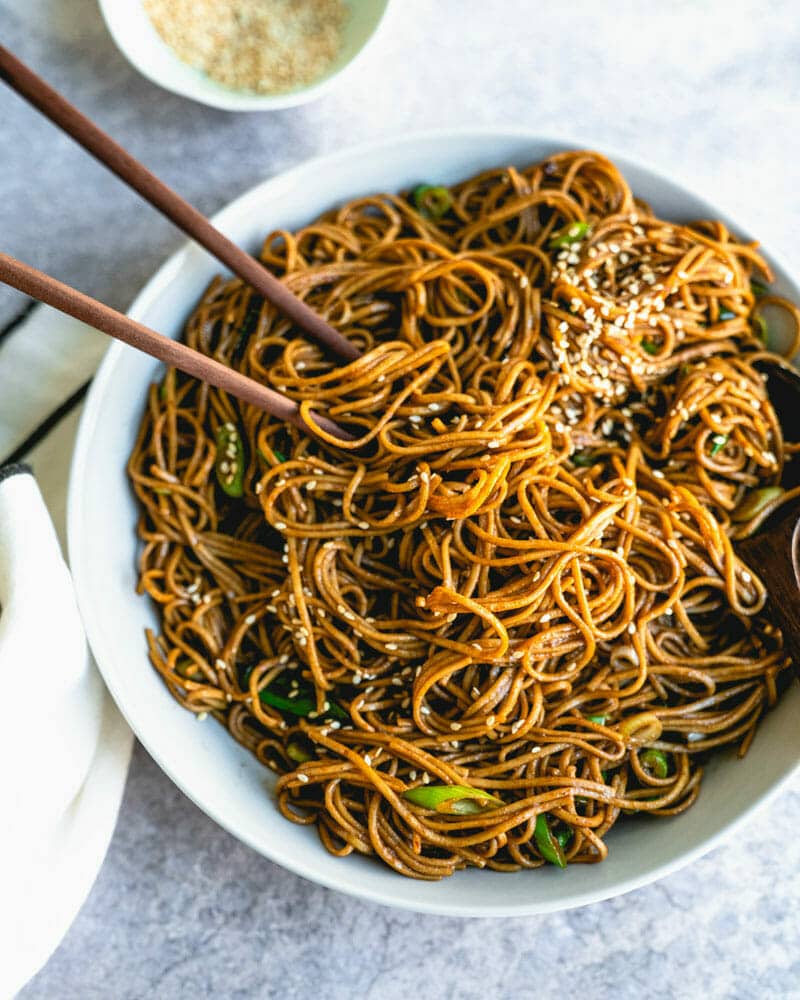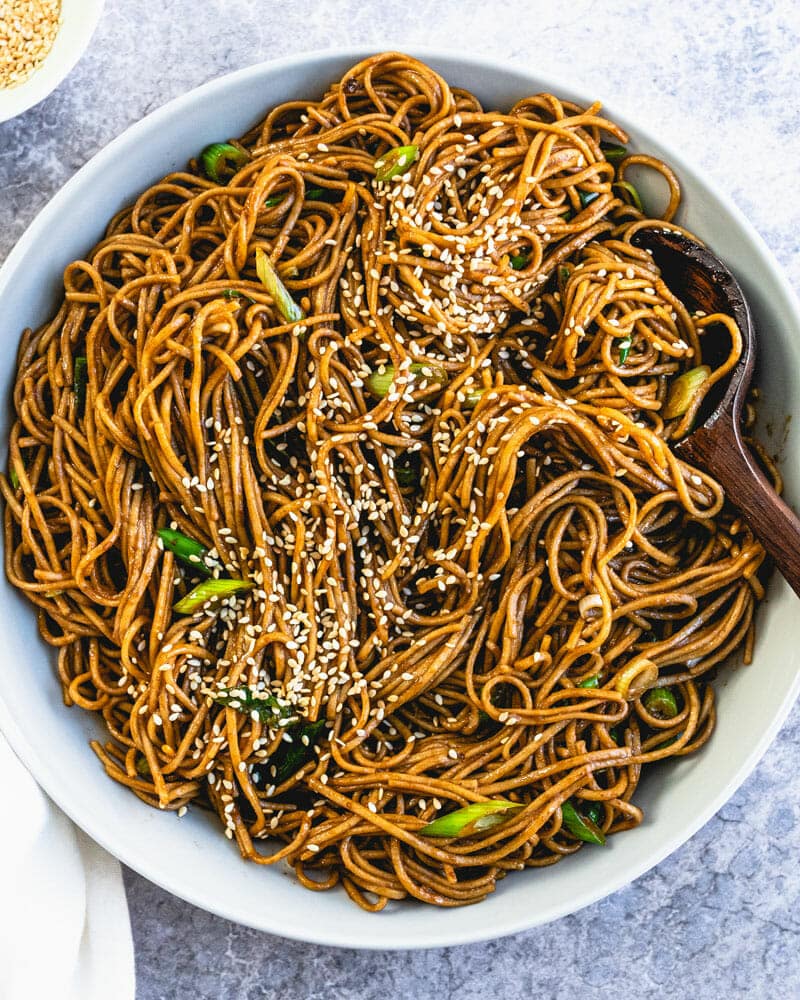Learn how to make quick soba noodles with this 15-minute recipe featuring a savory sesame-soy sauce. These Japanese buckwheat noodles are great for easy weeknight dinners and can be topped with eggs, tofu, or shrimp for a complete meal.

When I’m craving something satisfying but don’t have much time to cook, this quick soba noodles recipe has become a go-to! There’s something so comforting about these nutty buckwheat noodles tossed in a savory sesame-soy sauce. The best part? This recipe takes just 15 minutes from start to finish, making it perfect for those busy weeknight dinners when you need something fast but flavorful!
What started as a simple pantry dinner has become one of my family’s most-requested dishes. My kids love noodles of all kinds (naturally!) and I love how versatile this recipe is: perfect as a side dish or easily made into a complete meal with a sunny side up egg, sauteed shrimp or pan fried tofu.
5 star reader reviews
- “As a mom of 3 toddlers, this recipe is a life saver! Delicious, fast and unfuzzy! I will keep this recipe in my rotation.” -Eliana
- “I’ve had a package of soba noodles in my pantry for a while. Pulled them out tonight and made your recipe to go with a piece of wild-caught salmon. Both were delicious. Thanks, will make this again soon!” -Temptd2
Ingredient spotlight: soba noodles
Soba noodles are traditional Japanese noodles made from buckwheat flour, which gives them a slightly nutty flavor. Because they’re made from buckwheat, most soba noodles are naturally gluten-free. Some brands do add wheat flour, so I’d always check the package if you’re following a strict gluten-free diet.
I’ve tested dozens of soba noodle brands over the years, and I’ve found that quality varies based on the brand. Some are very thin and tend to break easily during cooking. I typically look for soba noodles that are slightly thicker and hold up better to boiling and rinsing. My go-to brands are usually found in the Asian section of the grocery store, and I recommend experimenting with a few different ones to find your preference.
A key difference between soba and regular pasta is that soba requires rinsing after cooking – this removes excess starch that would otherwise make the noodles gummy and prevent them from properly absorbing the sauce.

Essential sauce ingredients
This soba noodles recipe is fast and easy to make, and most of the ingredients are pantry staples! It’s essentially a pantry meal, aside from the green onion. You can even leave out the green onions if you don’t have them on hand! Here’s what’s in this soba noodles recipe:
- Soy sauce adds a savory flavor. I prefer regular soy sauce (not low sodium); or you can use tamari or liquid aminos as substitutes.
- Toasted sesame oil is crucial here. Make sure you’re using toasted sesame oil, not regular sesame oil. Toasted sesame oil has a strong flavor intended for finishing dishes; regular sesame oil is neutral and meant for cooking.
- Rice vinegar adds a touch of acidity to brighten the entire dish.
- Honey or maple syrup provides just a hint of sweetness that rounds out the flavors without making the dish sweet.
- Miso is my secret ingredient here. It’s a fermented soybean paste that adds incredible depth in flavor (umami). You can find miso at most major grocery stores near the other Japanese ingredients. There are many different types of miso, all with different flavors: red, yellow, and brown. I recommend using white or light miso here.
Expert tip: the rinsing technique
Rinsing pasta is not required for something like Italian spaghetti or penne. But for soba, rinsing is necessary to remove the starch that builds up during cooking. If you don’t rinse, the soba becomes very gummy and mushy. It also absorbs the sauce and becomes dry instead of saucy.
Here’s how I rinse soba noodles: as soon as they’re done cooking, I drain them in a fine-mesh strainer and immediately run cool water over them while gently tossing with my hands or tongs. I continue rinsing until the water runs clear – usually about 30 seconds. Then I shake the strainer to remove excess water. If I want to serve them warm, I quickly run warm water over them for just a few seconds before adding the sauce.

Why to toast sesame seeds
For the best flavor, garnish these soba noodles with toasted sesame seeds! Of course, you can just use straight up sesame seeds. But toasting your sesame seeds in a pan heightens the nutty flavor considerably.
It’s almost like using salt on food: it brings out the existing flavor and takes it to new heights! It only takes 3 minutes to toast sesame seeds, and you can store leftovers in a sealed container for months. Go to How to Toast Sesame Seeds.
Storage and reheating instructions
These soba noodles are best enjoyed fresh, but leftovers store well. Store leftover noodles in the refrigerator for up to 3 days in an airtight container. I actually prefer them cold or at room temperature for lunch – they make an excellent cold noodle salad.
Serving suggestions for soba noodles
One of the reasons I love this recipe so much is how easily it transforms from a simple side dish into a complete meal. Here are my favorite ways to serve these soba noodles:
- Top with an egg. The easiest way to make it dinner! Top with a sunny side up egg or soft boiled egg. Dinner, solved!
- Add protein with tofu. This pan fried tofu is our favorite method for weeknights, and our baked tofu gets rave reviews. Or try marinaded tofu, which is simple with no cooking required.
- Include seafood. Try this quick and healthy sauteed shrimp! Use plain sesame oil for cooking and add a drizzle of rice vinegar and soy sauce at the end (instead of the lemon). Or, serve alongside teriyaki salmon or shrimp and broccoli.
- Bulk up with vegetables. Try with easy edamame or spicy edamame, or serve it with stir fry vegetables.
- Make a noodle bowl. Combine with fresh cucumber slices, shredded carrots, and avocado for a refreshing cold noodle salad.
Dietary notes
This soba noodles recipe is vegetarian, vegan, plant-based, dairy-free and gluten-free.
Frequently asked questions
The sauce can be made up to 3 days in advance and stored in the refrigerator. However, I recommend cooking and assembling the noodles just before serving for the best texture.
Soba noodles are made from buckwheat flour and have a nuttier flavor than wheat pasta. They also require rinsing after cooking and have a slightly different texture.
While miso adds incredible depth, you can omit it if you don’t have any. The noodles will still be delicious, just with a slightly less complex flavor profile. You may want to add a pinch extra salt as well.
Not all soba noodles are gluten-free. Look for packages labeled “100% buckwheat” if you need to avoid gluten, as some brands include wheat flour.
Quick Soba Noodles
Learn how to make quick soba noodles with this 15-minute recipe featuring a savory sesame-soy sauce. These Japanese buckwheat noodles are great for easy weeknight dinners and can be topped with eggs, tofu, or shrimp for a complete meal.
- Prep Time: 10 minutes
- Cook Time: 5 minutes
- Total Time: 15 minutes
- Yield: 4
- Category: Side Dish
- Method: Stovetop
- Cuisine: Japanese
- Diet: Vegan
Ingredients
- 8 ounces soba noodles
- ¼ cup regular soy sauce (or substitute tamari or coconut aminos)
- 3 tablespoons toasted sesame oil
- 2 tablespoons rice vinegar
- 1 tablespoon honey or maple syrup
- 1 tablespoon miso (white or yellow)
- 1 teaspoon grated garlic
- 4 green onions
- Sriracha, to taste (optional)
- Toasted sesame seeds*
- To make it a meal: Fried egg or soft boiled egg, Pan fried tofu or Marinaded tofu, or Sauteed shrimp
Instructions
- Cook the noodles: Cook the soba noodles according to the package instructions: it should take about 4 to 5 minutes. Important: when the noodles are done cooking, rinse them under cool running water in a strainer, tossing them to remove the starch. Then shake off excess water. If you’d like the noodles to be warm when serving, run them under warm water for a few seconds; you can also serve room temperature or cold. (If you skip this step, the noodles soak up the sauce and become too dry.)
- Whisk the sauce: Meanwhile, in a medium bowl whisk together the soy sauce, toasted sesame oil, rice vinegar, honey or maple syrup, miso (if using), and grated garlic.
- Slice the onions: Thinly slice the green onions on the bias (diagonally), using both white and dark green parts.
- Combine and serve: Return the rinsed and shaken dry noodles to the pan or a bowl; stir in the sauce and green onions. Place in serving bowls, top with sesame seeds and serve.
Notes
*Toasting the sesame seeds really brings out the nutty flavor! It takes only 3 minutes and you can taste the difference. Store toasted sesame seeds for months in a sealed container in the pantry.

